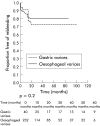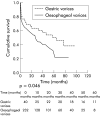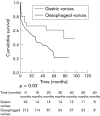The role of the transjugular intrahepatic portosystemic stent shunt (TIPSS) in the management of bleeding gastric varices: clinical and haemodynamic correlations
- PMID: 12117893
- PMCID: PMC1773295
- DOI: 10.1136/gut.51.2.270
The role of the transjugular intrahepatic portosystemic stent shunt (TIPSS) in the management of bleeding gastric varices: clinical and haemodynamic correlations
Abstract
Background: The transjugular intrahepatic portosystemic stent shunt (TIPSS) is effective in the management of both oesophageal and gastric variceal bleeding. Although it has been reported that gastric varices can bleed at pressures of < or = 12 mm Hg, this phenomenon has been little studied in the clinical setting.
Aims: To assess the efficacy of TIPSS on rebleeding and mortality following gastric and oesophageal variceal bleeding, and the importance of portal pressure in both groups.
Methods: Forty eligible patients who had bled from gastric varices and 232 from oesophageal varices were studied. Patients were also subdivided into those whose portal pressure gradients (PPG) prior to TIPSS were < or = 12 mm Hg (group 1) and >12 mm Hg (group 2).
Results: There was no difference in Child-Pugh score, age, sex, or alcohol related disease between patients bleeding from gastric or oesophageal varices. Patients who bled from gastric varices had a lower PPG pre-TIPSS (15.8 (0.8) v 21.44 (0.4) mm Hg; p<0.001). There was no difference in the rebleeding rate (20.0% v 14.7%; NS). There was a significant difference (p<0.05) in favour of the gastric varices group in the one year mortality (30.7% v 38.7%) and five year mortality (49.5% v 74.9%), particularly in those patients in group 2. Gastric variceal bleeding accounted for significantly more cases in group 1 than in group 2 (36.8% v 10.2%; p<0.001). Most patients in group 2 who rebled had a PPG post-TIPSS of >7 mm Hg.
Conclusions: TIPSS is equally effective in the prevention of rebleeding following gastric and oesophageal variceal bleeding. A significant proportion of gastric varices bleed at a PPG < or = 12 mm Hg. The improved mortality in patients with gastric variceal bleeding is seen only in those that bleed at a PPG >12 mm Hg, and warrants further study.
Figures



Comment in
-
Balloon occluded retrograde transvenous obliteration: a feasible alternative to transjugular intrahepatic portosystemic stent shunt.Gut. 2003 Apr;52(4):611-2. doi: 10.1136/gut.52.4.611-a. Gut. 2003. PMID: 12631682 Free PMC article. No abstract available.
-
TIPS for gastric varices.Gut. 2003 May;52(5):772; author reply 772. doi: 10.1136/gut.52.5.772. Gut. 2003. PMID: 12692074 Free PMC article. No abstract available.
-
Is tips shunt effective for secondary prophylaxis of gastric variceal hemorrhage?Gastroenterology. 2003 Jul;125(1):262-3; discussion 263-4. doi: 10.1016/s0016-5085(03)00827-8. Gastroenterology. 2003. PMID: 12851894 No abstract available.
References
-
- Garcia-Tsao G, Groszmann RJ, Fisher RL, et al. Portal pressure, presence of gastroesophageal varices and variceal bleeding. Hepatology 1985;5:419–24. - PubMed
-
- Feu F, Garcia-Pagan JC, Bosch J, et al. Relation between portal pressure response to pharmacotherapy and risk of recurrent variceal haemorrhage in patients with cirrhosis. Lancet 1995;346:1056–9. - PubMed
-
- Groszmann RJ, Bosch J, Grace ND, et al. Hemodynamic events in a prospective randomized trial of propranolol versus placebo in the prevention of a first variceal hemorrhage. Gastroenterology 1990;99:1401–7. - PubMed
-
- Sarin SK, Lahoti D, Saxena SP, et al. Prevalence, classification and natural history of gastric varices: a long-term follow-up study in 568 portal hypertension patients. Hepatology 1992;16:1343–9. - PubMed
Publication types
MeSH terms
LinkOut - more resources
Full Text Sources
Medical
Miscellaneous
